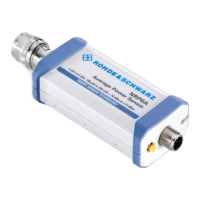Graphically representing power versus time (Scope mode) R&S NRP
1144.1400.12 2.20 E-2
2 Settings for reliable triggering
¾ Change to the Sensor menu.
Trigger … – ( )
* *
¾ Open the Trigger dialog box.
If the Trigger dialog box is opened in the Scope display, a
dotted line indicates the trigger threshold in the diagram.
¾
Source (trigger threshold)
Choose between external triggering (connector I/O2
at the rear) or internal triggering (derived from the
signal) and between positive or negative edge.
Note: Since I/O2 functions both as a trigger input
and analog output, be sure to select the cor-
rect setting (System
Æ
I/O dialog)!
¾
Level
In the case of internal triggering, set the trigger
threshold here.
9 Tip
When a ? symbol in the display shows, that the
sensor doesn’t trigger, the (DEL/1TRIG)-key can be
used to trigger the sensor once. The then appearing
graph often can give a hint how to choose trigger set-
tings.
Next … – ( )
* *
¾ Open the second page of the Trigger dialog box.
The
Holdoff and Hysteresis parameters allow you to make
settings that enable reliable triggering even in the case of
complex signals.
¾
Holdoff
Use this parameter to set the time range in which ad-
ditional trigger events (measured from the last suc-
cessful triggering) are to be ignored.
¾
Hysteresis
Setting the trigger hysteresis to a value other than
0 dB will prevent triggering from occurring again until
the measurement level has fallen below the trigger
threshold by at least this value.
For a detailed description of these parameters, refer to
Chapter 4, Trigger settings.

